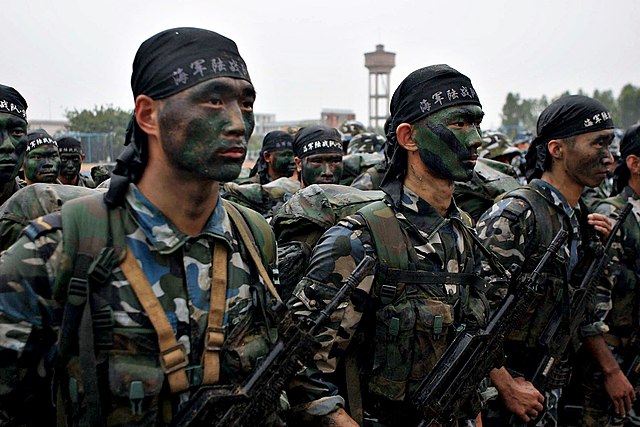Loading AI tools
Marine force of the People's Republic of China From Wikipedia, the free encyclopedia
The People's Liberation Army Navy Marine Corps (PLANMC), also known as the People's Liberation Army Marine Corps (PLAMC), is the marine force of the People's Liberation Army (PLA) and one of five major branches of the People's Liberation Army Navy (PLAN) responsible for amphibious warfare, expeditionary operations and rapid responses.[5] It currently consists of seven 6,000-man combined armed brigades and four other supporting brigades including aviation, engineering & chemical defense, artillery and service-support brigades for a total of 40,000. The marine corps also includes a brigade-level special operations unit called the "Jiaolong Commando Unit" (Chinese: 蛟龙突击队)[6][4], officially known as the 7th Marine Brigade.
| People's Liberation Army Navy Marine Corps | |
|---|---|
| 中国人民解放军海军陆战队 Zhōngguó Rénmín Jiěfàngjūn Hǎijūnlùzhànduì | |
 Patch of the People's Liberation Army Marine Corps | |
| Founded | April 1953 |
| Country | |
| Allegiance | |
| Branch | |
| Type | Naval infantry |
| Role | Amphibious warfare |
| Size | 40,000 personnel[1] |
| Part of | |
| Garrison/HQ | Chaozhou, Guangdong |
| Motto(s) | 陆地猛虎,海上蛟龙 (English: "Fierce Tiger of the land, Jiaolong of the sea")[2][3][4] |
| Colors | White Blue |
| Engagements | |


The present PLANMC was originally established in April 1953[7] to conduct amphibious operations against islands held by the Republic of China (Taiwan). By the end of the Korean War, the PLANMC numbered 110,000 personnel organized in eight divisions. However, the organization was disbanded in October 1957 when the leadership of China abandoned any plans to seize the island of Taiwan. Following the disbanding of the Marine Corps, the PLAN did maintain a naval infantry force, which consisted of several infantry and amphibious tank regiments.
In 1979 the Central Military Commission (CMC) re-established the Marine Corps and organized it under the PLAN. On 5 May 1980, the 1st Marine Brigade was activated on Hainan.
The PLANMC was expanded in the 1990s because of the growing tensions between China and Taiwan. The 1st Marine Brigade was reinforced and rearmed. In July 1998, the 164th Motorized Infantry Division of the PLA Ground Force's (PLAGF) 41st Group Army had been transferred to the PLAN South Sea Fleet and became the 164th Marine Brigade, with its homebase in Zhanjiang, Guangdong Province. In February 2017, it was reported that the 77th Motorized Infantry Brigade of the 26th Group Army was transferred to the PLAN.
The PLANMC participated in multiple international exercises, including participation in RIMPAC, and engaged with United States Marine Corps in mutual training and friendly cultural exchanges during the Bush and Obama administrations as part of its "tranquility and good order" policy according to its navy chief.[8] However, with the Trump administration the PLAN and PLANMC were dis-invited from the 2018 Rim of the Pacific and the US Marines are trained to fight against the PLANMC.[9][10][11]

The PLANMC is subordinate to Navy Headquarters, the Joint Staff Department and the CMC.
18,000 marines are under the Southern Theater Command, with 6,000 being under Eastern Theater Command and 12,000 being under Northern Theater Command.[6] These brigades possess combined arms units, including armor, artillery, missile, air defense, and logistics.
The Six brigades are as follows:
Each Marine Brigade is organized into the following elements:[6]
The PLA has additional amphibious assault capabilities in the PLAGF amphibious combined-arms brigades.[12]
This section needs additional citations for verification. (December 2021) |




Chinese marines use the QBZ-95 as their main armament, though this is set to change as the PLA is set to replace the QBZ-95 with the QBZ-191 as its standard service rifle.[13] The Type 07 Oceanic Camouflage used by the marines is likewise scheduled to be replaced by the Xingkong camouflage pattern.[14] The marines also make use of GPS and night vision systems to enhance their fighting capabilities.
The PLAN marines are equipped with amphibious light tanks and armored personnel carriers. The Type 63A is the newest light tank in Chinese service. It is based on the hull of the older Type 63 (which in turn is based on the Soviet PT76 amphibious light tank). The Type 63A features a number of improvements, in particular the new welded turret which features much greater armor protection and the 105mm main gun (capable of firing standard NATO projectiles as well as the gun launched anti-tank missile). The marines are believed to have continued operating the Type 63 and the non-amphibious Type 62 light tanks as secondary units. The Type 77 amphibious APC was the standard armored transport for the marines for many decades. However, new designs have been adapted from the army to complement these aging transports. These include specially modified versions of the Type 89 and Type 63 APCs, with enhanced swimming capabilities. The Type 86 (or WZ501) IFV is also in service with the marines. Based on the Soviet BMP-1, it is armed with a single 73mm main gun and mounts an HJ73 ATGM (with max range of 3000 meters).
For air defense, Chinese marines employ a mix of automatic and manually operated anti-aircraft artillery systems, as well as short range surface-to-air missiles. The marines have been seen operating the new Type 95 self-propelled air defense platform on an amphibious hull similar to the Type 77 APC. This platform is armed with four 25mm cannon with a short ranged SAM combination to achieve effective killing capabilities against low flying targets at short ranges. The Type 89 self-propelled 122mm gun is the first SP artillery system in service with the marines since 1999. This adds additional accurate firepower to the PLAMC.
Seamless Wikipedia browsing. On steroids.
Every time you click a link to Wikipedia, Wiktionary or Wikiquote in your browser's search results, it will show the modern Wikiwand interface.
Wikiwand extension is a five stars, simple, with minimum permission required to keep your browsing private, safe and transparent.